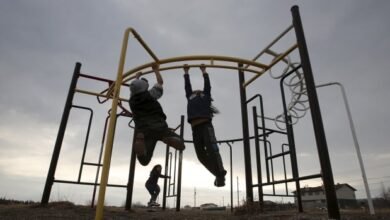As US election nears, migrants contemplate a perilous journey | US Election 2024 News

Experts also warn that the fevered rhetoric around immigration in the unfolding election could worsen a humanitarian crisis at the border and make it easier to justify harsh policies.
Last year, the International Organization for Migration, a United Nations entity, named the journey across the US-Mexico border the “deadliest land route for migrants worldwide on record”.
“There’s a lot at stake in terms of how this country wants to live,” Father Ray Riding, who volunteers with deportees and asylum seekers, told Al Jazeera. “When you dehumanise people, you can do whatever you want to them.”
In order to avoid a web of Border Patrol checkpoints that extend far into the US interior, many migrants spend days walking through remote routes deep in the desert where they are less likely to be apprehended.
After a long journey through Mexico — where migrants routinely face extortion, rape and abuse by law enforcement and criminal groups — the days of trekking through the desert represent a final, lethal test.
“The journey is horrific, and it doesn’t start in the borderlands. For many people, it starts thousands of miles away,” said Dora Rodriguez, a humanitarian worker who nearly died in the desert herself when political violence by a US-backed military government in El Salvador pushed her to flee to the US in the 1980s.
In the area around the Silver Bell Mountains, about 113 kilometres (70 miles) north of the US border with Mexico, there is little respite from the sun. It is at least 87 degrees Fahrenheit — or 30 degrees Celsius — by 11am when volunteers with the humanitarian group No More Deaths set out for their first hike.
They aim to drop off water and supplies at areas known for migrant activity.
The terrain is rocky, uneven and covered in thorny plants capable of wearing out an otherwise sturdy pair of shoes. Along with jugs of water and an assortment of salty, high-calorie foods, the volunteers leave buckets of thick socks.
“Something as mild as a sprained ankle or a blister can be lethal in the desert,” said Kyla Neilan, a volunteer who has worked with No More Deaths for 10 years. “If a migrant can’t keep up with their group, they can get lost or left behind.”
Other problems that would normally pose few serious health risks can also prove deadly. Some migrants get diarrhoea when desperation pushes them to drink from cattle troughs filled with algae — and the condition can lead to further dehydration.
Neilan and others like her are insistent that, while migrant deaths are most often attributable to exposure to the elements, they are a direct result of US border policy.
First outlined in a 1994 Border Patrol planning document, “prevention through deterrence” relied on a simple assumption: that focusing law enforcement resources on urban ports of entry would deter people from crossing. The idea would be that migrants would give up once faced with “hostile terrain, less suited for crossing”.

Though that policy has failed to stop migrants from coming to the US, it has undoubtedly succeeded in making their journey more deadly.
Greg Hess, the Pima County Medical Examiner, told Al Jazeera that it was relatively uncommon to find the bodies of deceased migrants in the desert around Tucson in the 1990s, when border policies first began funnelling migrants into increasingly remote areas.
“We average about 170 [deceased migrant] remains per year if you’re looking from 2002 through 2023,” he said, citing figures for Pima County. “That’s in contrast to less than 20 back in the 1990s.”
Throughout the day, Neilan and two more volunteers drop 48 gallons of water at several points in the desert. They calculate common migrant routes using a combination of geographic mapping and indicators such as locations where bodies have frequently been found.
Faced with brutal elements and scavenging animals like javelinas, vultures and coyotes, bodies often disappear with little trace. Neilan says No More Deaths has volunteer doctors and pictorial guides to help differentiate animal bones from human ones.
By 1:30pm, the heat had risen to 94F, or a sweltering 34C. During the summer, the volunteers say that temperatures of 116F, or 47C, are common.
“We are at risk of heat illness ourselves out in the field, and we’re hiking relatively short distances with frequent breaks back in an air-conditioned truck packed with water,” said Neilan. “Imagine what the risk is like for migrants who have spent days trekking through the desert with little food or water.”
Source link



